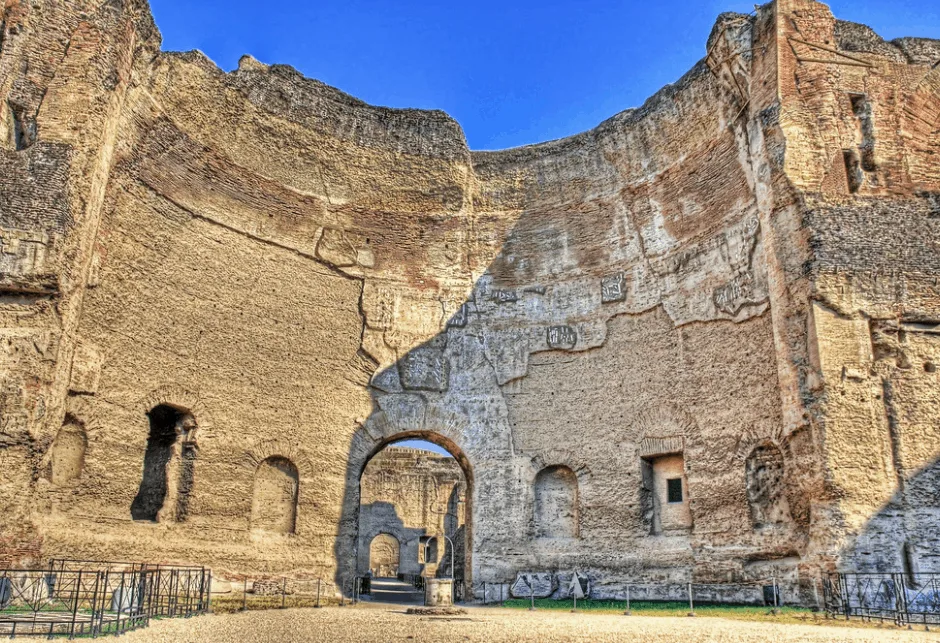The Romans surely enjoyed a dive into a hot bath, and for this pastime, they built massive bathhouses. The ruins of these “thermae” can be found all across the city of Rome and have become popular tourist attractions.
In this post, you’ll discover the ultimate list of facts about the Baths of Caracalla, one of the largest Ancient Roman bathhouses ever constructed and completed during the reign of Emperor Caracalla.
1. The Baths of Caracalla are located in the south of Rome
The Baths of Caracalla is a huge Ancient Roman thermal bath complex located in the south of the city of Rome in Regio XII, one of the 14 administrative regions of Rome divided by the first Roman Emperor, Augustus.
They can be found just a few hundred meters directly south of the Roman Colosseum and to the southwest of the Circus Maximus and Roman Forum, the main marketplace of Ancient Rome.

2. The complex was built on top of a former Roman villa complex
It’s estimated that the construction of the Baths of Caracalla started around the year 211 and the location was used to house a large estate with an immense garden belonging to a famous Roman soldier and politician named Gaius Asinius Pollio.
This estate was constructed during the reign of Roman Emperor Augustus (27 B.C. – 14 A.D.) and was referred to as the “Horti Asiniani.” The Severan Dynasty also built the Via Nova, which leads directly from Palatine Hill to the baths, which formed an easy connection to the city center of Ancient Rome.
One of the most remarkable facts about the Baths of Caracalla is that the old structures of the villa complex were demolished to the first-floor level and incorporated into the foundations of the baths. Some of these ancient structures dating back to Augustus were excavated in the 19th century and were discovered virtually untouched.
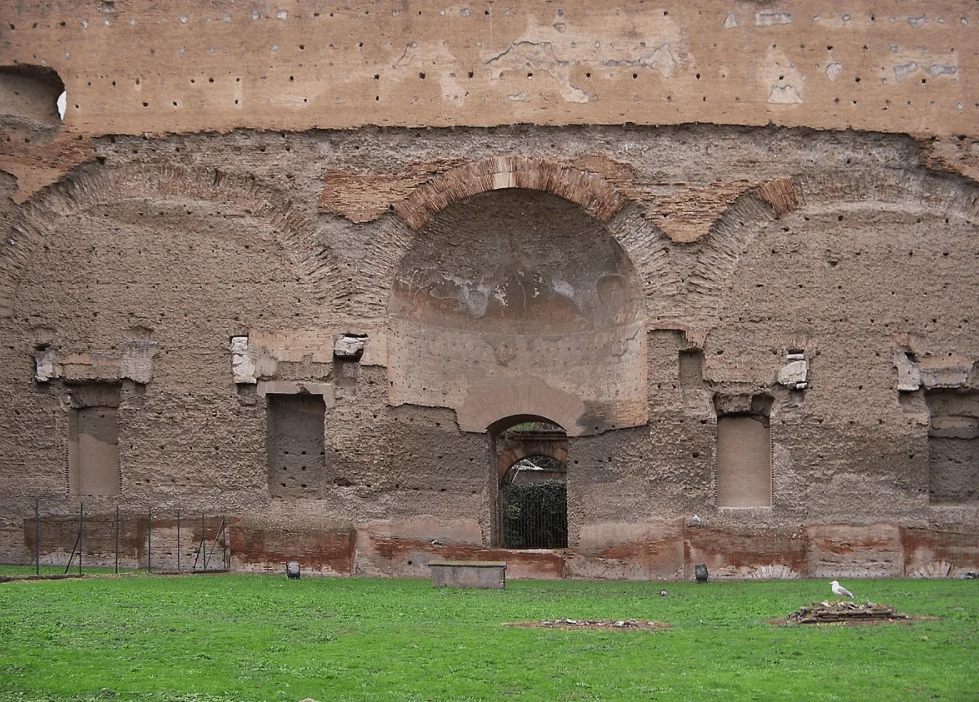
3. It took 5 to 6 years to complete the massive baths
Construction of the baths started during the reign of Septimius Severus and was completed during the reign of his son, Caracalla, which is how the baths got their name.
It’s not exactly sure when the construction of the baths was started, but they were certainly inaugurated in the year 216 A.D. This means that it took just 5 to 6 years to build this huge complex.
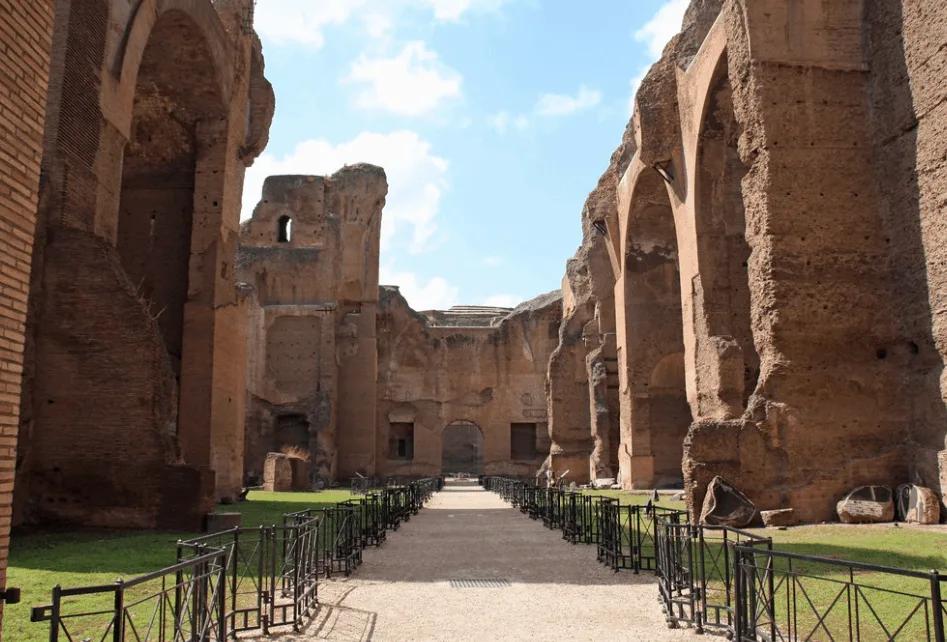
4. The bath complex is huge

One of the most interesting facts about the Baths of Caracalla is this complex is simply massive. It’s built on an area of 412 × 393 meters (1,352 × 1,289 feet) and the buildings themselves cover an area of 337 × 328 meters (1,106 × 1,076 feet).
A total of 252 huge marble columns were used and Egyptian granite was imported to build 8 huge pillars to support the 44 meters (145 feet) high roof of the main building, which had a size of 214 × 110 meters (702 x× 361 feet).
An estimated 17.5 million regular bricks were used and a total of 520,000 large bricks to construct all the buildings, which means a total of 2,000 metric tons (2,200 short tons) of material had to be installed to complete the project in 6 years.
This simply means that thousands of workers had to be on the site every single day for half a decade to build this enormous complex!

5. The Baths of Caracalla were equipped with central heating
One of the most fascinating facts about the Baths of Caracalla isn’t just that they are so huge, but also that they had pretty modern systems in place, considering they were built over 1,800 years ago!
A system of interconnected tunnels was constructed below the buildings of the complex through which hot air was blown. This means that the buildings and baths were heated with a hypocaust, a form of central heating that runs below ground level.
6. Over 10 tonnes of wood was burned every single day
Operating these baths must have been extremely expensive because they were open and free to the general public. In its glory days, the complex could entertain up to 1,600 guests at the same time and it’s estimated that between 6,000 and 8,000 people visited the baths every single day.
To heat the water in the baths and buildings, it’s estimated that about 10 tonnes of wood were burned every single day! This also means that the tunnels beneath the complex were used as storage for the huge amount of wood that was needed to operate the baths.
These tunnels, which could store about 2,000 tonnes of wood, were equipped with ventilation holes as well to ensure the wood wouldn’t rot.

7. The bathhouse was operational for over 300 years
The baths were operational from their inauguration in 206 A.D. until the year 537 A.D. This was the year that Rome was besieged by the Ostrogoths, a Germanic people in the Roman Empire who followed the Visigoths.
During the Gothic War, the main aqueduct that supplied the baths with water was destroyed. Without water running through the water pipes, the baths couldn’t be operated anymore and they were abandoned shortly after.
After more than 300 years of providing entertainment for the people of Rome, the Baths of Caracalla were no more!
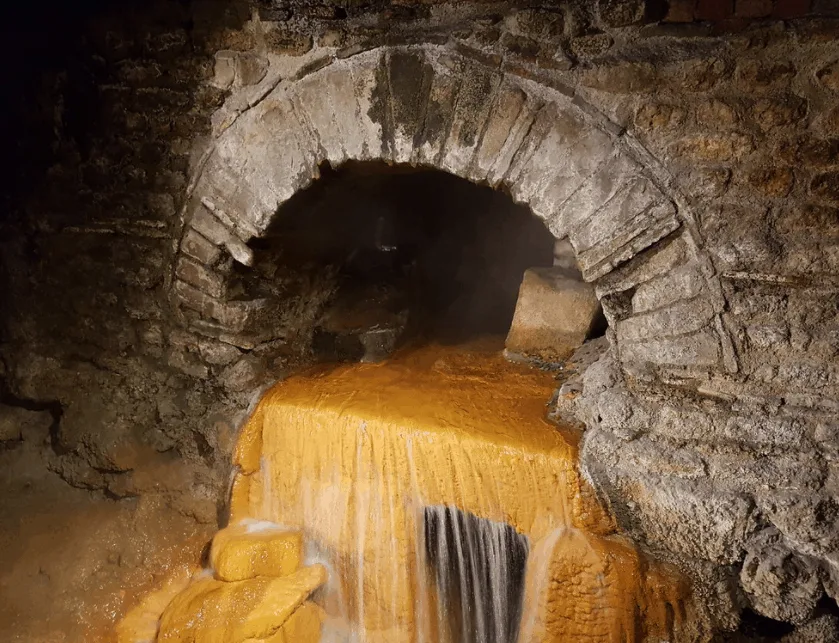
8. The buildings were destroyed by an earthquake in the 9th century
The baths lay in complete ruin today, even though some walls of the main building still stand. Most of the buildings were destroyed by a massive earthquake that happened in the year 847 A.D.

9. Materials of the baths were used in several other structures
In medieval times, the massive ruins were used as a quarry, and the materials were used for the construction of several other projects.
Some of the most notable include the Basilica of Santa Maria in Trastevere, a minor basilica in Rome, and the Pisa Cathedral, a popular church because of its world-famous tower, the Leaning Tower of Pisa.

10. A museum was created to display the huge number of artifacts found at the site
The excavations to extract materials were continued for multiple centuries, which clearly emphasizes the massive scale that the project must have been.
Several Popes used columns and other decorations to build palaces and villas, and excavations conducted in the 16th century by Pope Paul III uncovered a huge number of artifacts, including a large number of bronze and marble statues.
Because of this, a museum was created to display all of the artifacts called the “Museo Farnese,” which eventually became the “Farnese Collection” and was moved to the National Archaeological Museum in Naples.

11. The collection contains some of the most famous Ancient Roman sculptures
The museum in Naples holds some of the most famous and influential Ancient Roman sculptures. These include the Farnese Hercules, Farnese Cup, Farnese Bull, and the Farnese Atlas.
One of the most fascinating facts about the Baths of Caracalla is that some of these sculptures such as the Farnese Bull were already present in the Ancient Roman villa of Gaius Asinius Pollio of which part of the first floor was used as the foundation for the baths.
This means that the Farnese Bull, which was later moved into the baths as decoration, was used to decorate the garden of Pollio’s villa over 2 centuries before the baths were constructed.

12. The complex was much more than just baths and even housed a library
Another one of these intriguing facts about the Baths of Caracalla is that these weren’t merely baths. This was literally a complete Ancient Roman entertainment center that offered a lot more than a plunge into hot water.
The complex housed a public library, which was just the second library ever in a bath complex, an Olympic size pool of 54 × 23 meters (177 × 75 feet), and 2 gyms where people could train in wrestling and boxing.
The hot room or “caldarium“, the central section of the entire complex, was covered with a dome of about the same size as the famous dome of the Pantheon in Rome, the Ancient Roman temple that was transformed into a Catholic church.
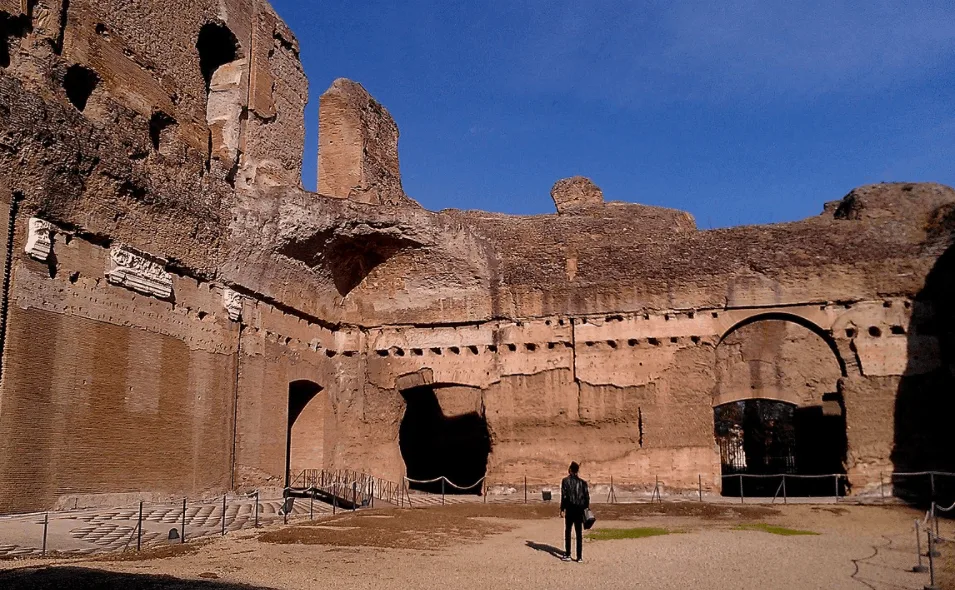
13. One of the bathtubs is now a fountain on a Roman square
Some of the elements of the Baths of Caracalla have been incorporated into the modern-day landscape. One of the columns that used to support the roof of the pool at that bath was installed in the Piazza Santa Trinita in central Florence.
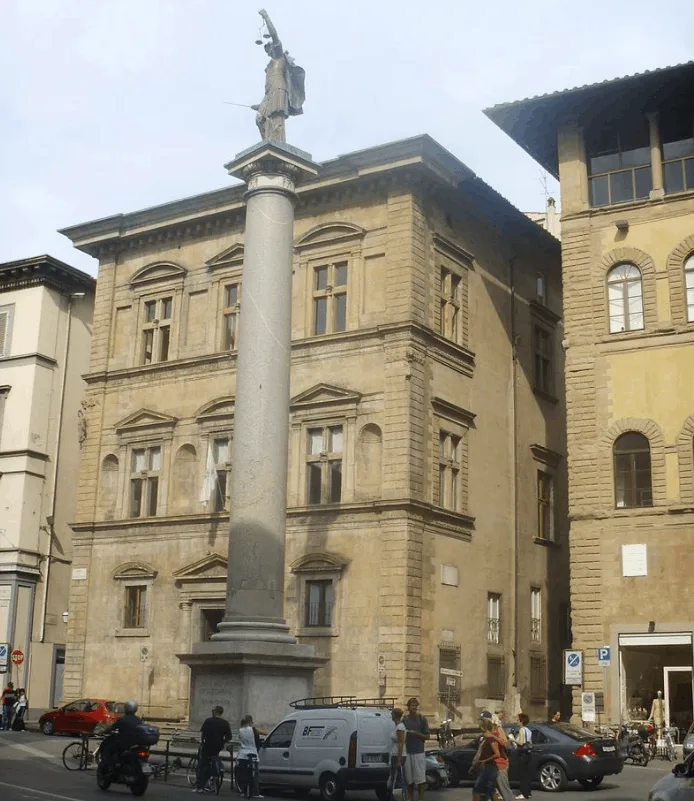
An even more remarkable monument taken from the baths is a bathtub that was once used by Ancient Romans. This bathtub can now be found in front of the Palazzo Farnese on the Piazza Farnese and serves as a fountain to decorate the square in central Rome.
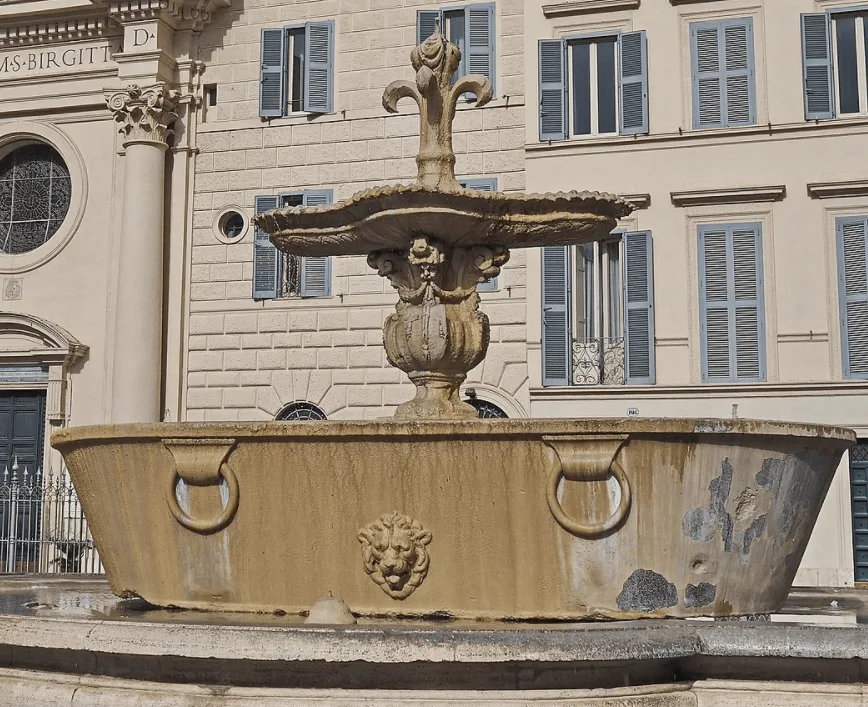
Italy is a fascinating country, don’t you think?
14. The baths have inspired both ancient and modern structures
Believe it or not, the Baths of Caracalla weren’t even the largest baths ever constructed in Ancient Rome. The Baths of Diocletian, completed during the reign of Emperor Diocletian, were even bigger and were inspired by them. The Basilica of Maxentius on the Roman Forum is another building that was inspired by the baths.
Some buildings in modern times were also inspired by the baths, including the Pennsylvania Station in New York City which was demolished in 1963, and the main halls of Penn Station and Chicago Union Station.
The Great Hall of St. George’s Hall in Liverpool was also directly inspired by the architecture of the baths!
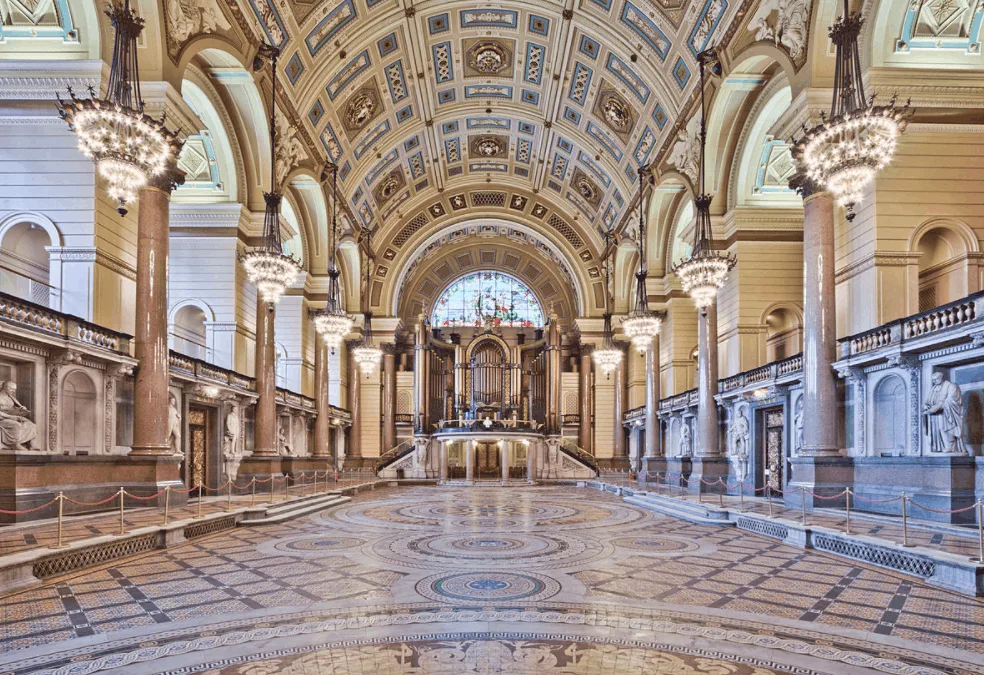
15. It’s one of the most popular tourist attractions in Rome
As one of the largest complexes ever built in Ancient Rome which is open to the public, the Baths of Caracalla are an important tourist attraction in Rome. You really have to see for yourself how large the complex really is as it’s hard to put into words.
You really have to stand in awe when thinking about the fact that the construction workers didn’t have any modern tools available, which makes it all the more impressive that this huge project was completed in just 5 to 6 years!
